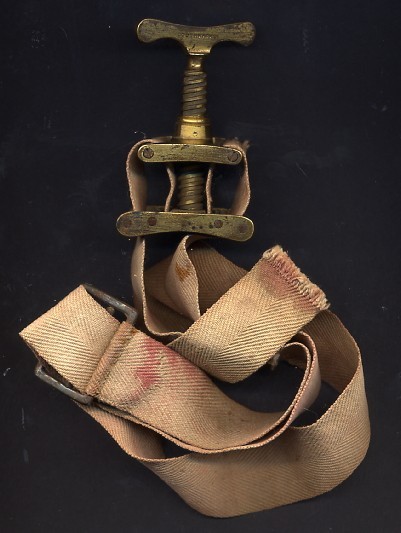The Surgeon’s Blade: The field tourniquet
May 12, 2017 - Mick Crumplin in News & Blog Posts, The Surgeon's Blade
Mick Crumplin continues his medical blog by looking at the use of the field tourniquet during the Napoleonic wars
The Tourniquet (any instrument or device for temporarily constricting an artery of the arm or leg to control bleeding – the word is derived from 17th C. French – a device that operates by turning, from tourner, to turn)
Since around 75% of injured survivors have traditionally been wounded in the limbs, it would seem that the tourniquet is a fundamentally important piece of field equipment to carry on a soldier’s person.
A British officer married to a French lady, was present at the siege of Badajoz in the spring of 1812. She had reminded him to carry a silk tourniquet with him in one of the severe assaults on the fortress. He forgot and exsanguinated from a leg injury in one of the breaches.
Fairly recently there was a paper from the American medical forces in Afghanistan, which reported that with the provision of all men with field tourniquets, deaths from haemorrhage at the combat site had fallen by 30%.
Two hundred years ago, there were two types of tourniquet; the field tourniquet and the operating tourniquet – the latter being a more sophisticated piece of kit.
The field tourniquet was basically a strong strap (for example, made of canvas) which could be applied and then tightened and secured, using either a brass buckle or a windlass bar, rotating a short ebony or bone polished bar, which was then fixed under the tightened strap after turning adequately.
These straps were easily applied at the site of injury. Of course, other makeshift techniques were used during the heat of combat, for example, using bayonets or ramrods to twist the strap or neckerchief tight round a limb.
The operating tourniquet of choice 200 years ago was the Petit screw apparatus. Invented by Jean Louis Petit, a French surgeon, in 1718, a canvas strap was tightened by screwing up a brass apparatus. The great thing about this instrument was that it could be loosened and tightened quickly and simply. So it was screwed up to provide a bloodless field for the surgeon and let down for checking that the bleeding had been controlled (with ligatures). If there was concern about reactionary bleeding, it could be left on the limb in a loose manner.
Its disadvantages were that, occasionally the strap might break and also it was pretty uncomfortable. If left on too long, there would be disastrous consequences.
The tightness of the strap could reduce the blood supply to nerves and this could slightly ease the pain of the surgery temporarily. In the early part of the 18th century the Petit tourniquet was one of the most notable medical inventions. This apparatus was, for more than a century without any significant change, in the surgical instrument sets of most countries.
Mick Crumplin is the author of The Bloody Fields of Waterloo: Medical Support at Wellington’s Greatest Battle. Email [email protected] for more information.



